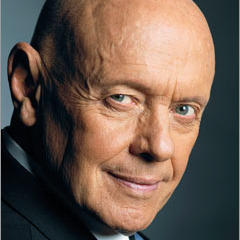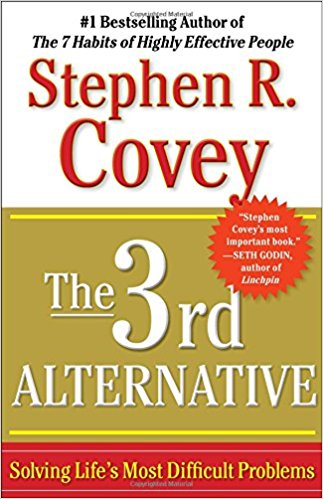The 3rd Alternative Summary
7 min read ⌚
 Solving Life’s Most Difficult Problems
Solving Life’s Most Difficult Problems
Stuck in a “fight or flight” mentality ever since the days of the Neanderthals and unable to break free?
Well, Stephen Covey says that there’s an alternative to these two options.
It’s “The 3rd Alternative” – and it’s a way of life.
And it can help you solve life’s most difficult problems.
Who Should Read “The 3rd Alternative”? And Why?
We’ve already told you a lot about Stephen R. Covey, and, if you have to take one thing from it all, it’s probably this: he was much too prominent and respected self-help thinker and educator for you to need a special reason to read any of his books.
However, if you’ve never read “The 7 Habits of Highly Effective People” we advise you to read that one before you delve into “The 3rd Alternative.”
If you are one of the millions and millions of people who have bought and read Stephen Covey’s masterpiece, then you need no further recommendation than this: “3rd Alternative” develops further the fifth and sixth habit first presented in that book.
And Covey considered it an essential addition.
About Stephen Covey
Stephen Covey was an American writer , educator, and businessman, named by “Time” magazine one of the “25 Most Influential Americans” back in 1996, and still – half a decade after his death – one of the Top 3 most popular self-help authors according to Amazon.
, educator, and businessman, named by “Time” magazine one of the “25 Most Influential Americans” back in 1996, and still – half a decade after his death – one of the Top 3 most popular self-help authors according to Amazon.
He rose to fame with “The 7 Habits of Highly Effective People,” a book “Forbes” magazine recently named one of the 10 best business books in history.
Many books followed, among them “First Things First” (co-authored with Roger and Rebecca Merrill), “Principle-Centered Leadership” and “The 8th Habit.”
After a cycling accident, Stephen Covey passed away on July 16, 2012, at the age of 79.
“The 3rd Alternative PDF Summary”
“The 3rd Alternative” was published in 2011; and, unfortunately, it ended up being Stephen Covey’s last book.
However, it is a fitting end to a remarkable life: a 500-page testimonial which spends about a fifth of its pages defining and explaining the 3rd alternative into detail, and then moves on to explore its practical applications at work, at home, at school, in law, in society, and in the world.
Early in the second – longest and most important – chapter (alliteratively titled “The 3rd Alternative: The Principle, Paradigm, and Process of Synergy”), Covey makes his intentions and goals clear:
“There is a way to solve the toughest problems we face, even those that look unsolvable,” he writes. “There is a path that cuts through nearly all life’s dilemmas and deep divisions. There is a way forward. It’s not your way, and it’s not my way. It’s a higher way. It’s a better way than any of us have thought of before. I call it ‘the 3rd Alternative’.”
In a nutshell, what this Hegelian logic tries to tell us is quite straightforward.
Namely, that most conflicts have two sides and that neither of them is the right one. Not because they are both wrong, but, quite contrary, because they both have inherent merits.
Compromising makes both sides lose. And as Michael Scott taught us once, it is not ideal:
Synergizing – i.e., the 3rd alternative – has the opposite effect. It’s a win-win situation because it’s the higher way, the synthesis of two opposing theses, which doesn’t work merely as a compromise, but also as a mind-widening solution which transcends the needs of the “I” and “You.”
If you remember well, synergize was the sixth of Covey’s original seven habits of highly efficient people. And, in fact, “The 3rd Alternative” is a detailed look at it and its related habits from the “Interdependence” spectrum: “think win-win” and “seek first to understand than to be understood.”
To acquire a 3rd alternative mind mode, you need to learn to apply four thinking paradigms.
Let’s have a look at each of them.
Paradigm 1: I See Myself
This is the obvious foundation of every proper thinking process.
That is, practicing the Ancient Greek art of knowing thyself.
Because once you step outside of the boundaries of your limitations and ego, you achieve a small “private victory” which will help you understand the needs of the other and the real problem behind the lack of solution.
Which brings us to –
Paradigm 2: I See You
Now that you’ve understood your side of the story for yourself try doing the same with the story of the one you have a conflict with.
Step outside your shoes and into the shoes of the other.
Now you’re ready for –
Paradigm 3: I Seek You Out
This is Covey’s final extrapolation and clarification of the “seek first to understand than to be understood” habit – which he mentions that had had the most significant impact on his life out of all seven (and, later on, eight) habits.
The trick is simple:
Don’t expect the others to understand you if you don’t put the effort to understand them first.
Once you do that – you’re ready for the magic, the miracle of synergy!
Paradigm 4: I Synergize with You
This is, obviously, the longest and most important part of the 4-step process towards synergizing. And is, in fact, split into four processes itself.
1. Ask the 3rd Alternative Question
Covey says it’s revolutionary since it doesn’t ask anyone to give up his idea; it merely asks the other to check if his approach is the best one.
And the question?
Here it is:
“Are you willing to go for a solution that is better than any of us have come up with yet?“
2. Define Criteria of Success
This part starts with a question itself: “What would better look like?”
The idea?
To come up with a clear vision of what’s to follow, criteria which will satisfy both parties in the discussion.
3. Create 3rd Alternatives
During this part, you and your partner turn the thinking process upside down, creating prototypes, brainstorming new frameworks, and, most importantly, suspending judgment for a while.
The trick?
Experimenting with radical possibilities.
Because, after all, they are the ones we see the least.
4. Arrive at Synergy
It’s easy from thereon.
Because some of these solutions will be the 3rd alternative.
And it will incorporate the best from both worlds, making both sides happy and content.
Key Lessons from “The 3rd Alternative”
1. Paradigm 1: I See Myself
2. Paradigm 2: I See You
3. Paradigm 3: I Seek You Out
4. Paradigm 4: I Synergize with You
Paradigm 1: I See Myself
Conflict resolution shouldn’t be about compromises. It should be about synergy.
And you can arrive at synergy if you start by trying to find out the limitations and the flaws in your solution. Or, better yet, understand your needs and interests.
At this stage, you need to ask yourself questions such as these:
What’s my story? Do I need to change the script?
1. Where might I have blind spots about myself?
2. How has my cultural programming influenced my thinking?
3. What are my real motives?
4. Are my assumptions accurate?
5. In what way are my assumptions incomplete?
6. Am I contributing to an outcome – an end to the story – that I really want?
Paradigm 2: I See You
Afterward, you need to move on to seeing the other, or, to use an old Roman adage, hearing out the other side as well.
It’s about seeing others as people instead of things.
Which means: see the other in terms of what he actually is, and not in terms of what his age, sex, nationality, religion, sexual orientation influence you to see him.
Paradigm 3: I Seek You Out
“I seek you out” is all about adopting the attitude of “You disagree? I need to listen to you.”
It is the exact opposite of “I defend myself against you.”
In the eyes of someone using thinking paradigm 3, a conflict is not a problem, but an opportunity.
Paradigm 4: I Synergize with You
In paradigm 4, you are able to use that opportunity.
You start by asking the other the 3rd alternative revolutionary question: “Are you willing to go for a solution that is better than any of us have come up with yet?“
Then you move on to defining the criteria which will make both parties happy.
Afterward, you brainstorm radical solutions and check them against the pre-defined criteria.
Finally, you synergize, i.e., you arrive at a solution which transcends compromises and middle grounds.
The higher way.
The “our” way.
Like this summary? We’d like to invite you to download our free 12 min app, for more amazing summaries and audiobooks.
“The 3rd Alternative Quotes”
We hear a lot about identity theft when someone takes your wallet and pretends to be you and uses your credit cards. But the more serious identity theft is to get swallowed up in other people's definition of you. Share on X When man created the mirror, he began to lose his soul. He became more concerned with his image than with his self. Share on X The 3rd Alternative is more than an armistice, and far more than a compromise – it’s about creating a new reality that is better than what’s ‘on the one hand’ or ‘on the other hand.’ Share on X ’Are you willing to go for a solution that is better than either of one has in mind?’ The question changes everything. Share on X 3rd Alternative thinking has to transcend the principle of fairness. Share on XOur Critical Review
If you’ve read Covey’s previous books, you’ll find very few original things in “The 3rd Alternative” – speaking on a purely philosophical plane.
However, in terms of applicability and step-by-step guiding manuals – you’ll not be disappointed a bit. “The 3rd Alternative” has them and has them in abundance.
And you’ll certainly profit from using them!
Emir is the Head of Marketing at 12min. In his spare time, he loves to meditate and play soccer.


 Solving Life’s Most Difficult Problems
Solving Life’s Most Difficult Problems




